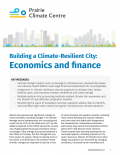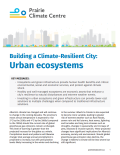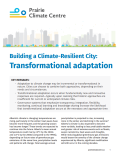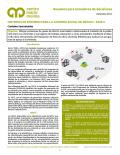
Alberta has experienced significant changes in recent decades, including changes in its climate. Average annual temperatures are increasing and could rise by 2.0°C by the 2030s and 4.0°C by the 2060s (compared to the 1990s) should the current rate of global greenhouse gas emissions remain unchanged. Total average annual precipitation...

Alberta’s climate has changed and will continue to change in the coming decades. The province’s mean annual temperature is expected to rise 2°C by the 2030s and 4°C by the 2060s (compared to the 1990s) should the current rate of global greenhouse gas emissions remain unchanged. This level of warming...

Alberta’s climate is changing: temperatures are rising, particularly in the winter; heat waves have become more frequent; and the growing season has become longer. These trends are expected to continue into the future. Alberta’s mean annual temperature could rise by 2.0°C by the 2030s and 4.0°C by the 2060s (compared...

In recent decades, Alberta has experienced significant changes in its climate as well as its economy, population and environment. The province’s mean annual temperatures are increasing and projected to continue to rise in the coming decades—potentially by 2.0°C by the 2030s and 4.0°C by the 2060s (compared to the 1990s)—should...

Through in depth case studies in Mexican cities, the Mario Molina Center proposed the location of social housing as an indicator of urban sprawl. Together with the government and construction companies, the Mario Molina Center has developed a tool to change incentives in the market so that development of future social housing...

Karnataka has a population of over 60 million which is growing at over 2% per annum. It is the eighth largest and fifth most urbanised state in India, with 37% population living in cities. It contributes over 5% to India’s GDP and has been growing at over 7% in the...

This report studies green growth trends, challenges and opportunities in the City of Kitakyushu, Japan. It firstly analyses socio-economic trends and the environmental performance of Kitakyushu; secondly reviews urban policies for land use, transport, buildings, waste, energy, water and industries that contribute to economic growth and reduce pressure on the...

This report analyses the economic and environmental performance of Thailand’s Bangkok Metropolitan Region (BMR), assesses its policies and governance practices that promote green growth, and provides recommendations to enhance its green growth potential. Green growth aims to safeguard the natural assets, resources and environmental services on which our well-being relies. Cities play...

This report examines the green growth potential and identifies best practices for policy and governance as well as ways to strengthen current practices. As the third largest city in Vietnam, Hai Phong’s economy is growing remarkably at an average rate of 8.7% (2015) in tandem with the growth of the...

Bandung Metropolitan Area (BMA) is home to 8.6 million people and is Indonesia’s second-largest urban agglomeration. Rapid growth has created a number of challenges for the city, including traffic congestion, air pollution, municipal solid waste and water access and management. The BMA also faces several acute disaster risks primarily related...
